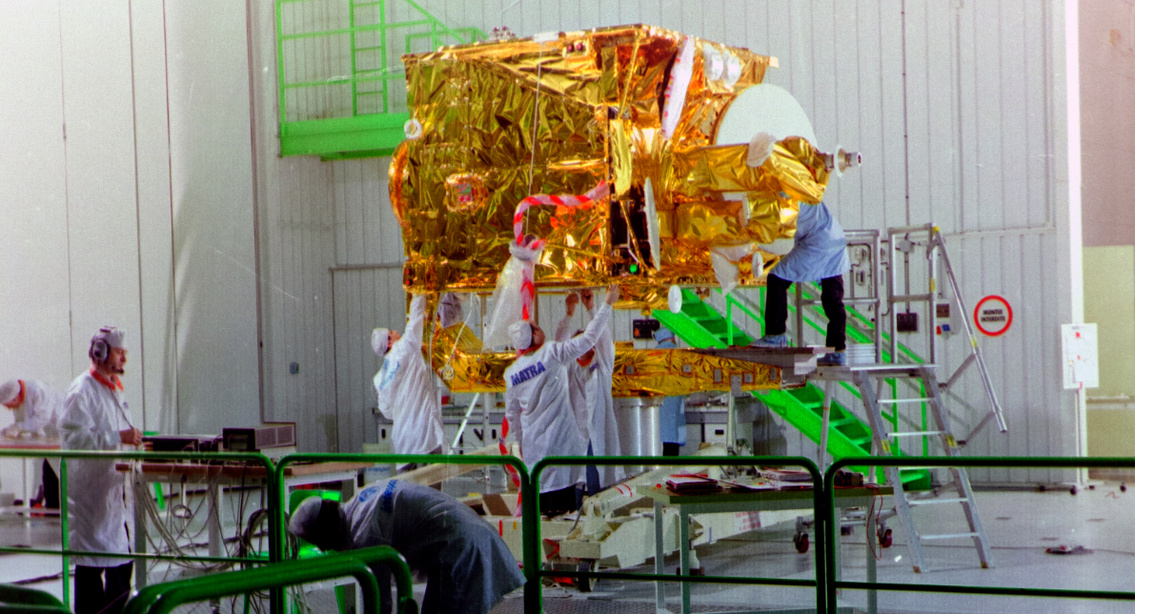
|
13 septiembre 2022
The constitution of HISPASAT in 1989 allowed Spain to join the small group of countries with its own satellite operator that exploited its sovereign orbital rights and provided commercial, government and defense communications services. A strategic step from then that today makes it possible for HISPASAT not only to maintain its position in Spain, but to be an authorized voice in Europe and the reference operator in Latin America for the reduction of the digital divide and the distribution of audiovisual services.
That adventure began soon, with the first meeting of the company's board of directors, which approved the opening of negotiations with the French company Matra for the construction of the first two satellites; Five months later the contract was signed. The commitment with the French company extended to three satellites: Hispasat 1A and 1B would be put into orbit in 1992 and 1993 and a third would remain dismantled in reserve. Shortly after, it was decided to award the delicate operation of launching the first satellite to the European Arianespace consortium. The satellite would be operational in the 30° West orbital position, which offered privileged coverage over Europe and America.
In a record time of 30 months, all the elements of Hispasat 1A had already been designed, manufactured and integrated. To accelerate the execution of the project, Matra, the manufacturing company, relied on the main subcontractors British Aeroespace and Marconi Space Systems. The Spanish industry committed to 30% of the program, thus beginning the driving vocation that HISPASAT has maintained with it ever since and which, to date, has brought returns of more than 1,000 million euros. In the same period of 30 months, the Arganda del Rey (Madrid) satellite control center became fully operational, inaugurated on July 12, 1992. The integration of the center was carried out by Inisel Espacio, subcontracted by Matra Marconi.
In 1992, Spain was a prominent player on the international stage with the Olympic Games in Barcelona and the Universal Exhibition in Seville, while in the area of infrastructure the first high-speed train had begun to operate. These relevant milestones were joined in mid-September by the launch of Hispasat 1A, which was prepared at the Arianespace facilities in Kourou (French Guiana).
At 20:04 on September 10, 1992 (1:04 hours on September 11 in Spain), the engines of the Ariane 4 launcher were started. It had in its hold the Hispasat 1A, weighing 2.1 tons, and another American satellite, Satcom C3. As exceptional eyewitnesses of the launch there were almost a hundred politicians, businessmen, professionals and journalists who were part of the Spanish delegation. At its head were the then prince Felipe de Borbón, today Felipe VI; the then Minister of Public Works and Transport Josep Borrell; the general secretary of Communications and president of Hispasat, Elena Salgado; and the company's CEO, Gabriel Barrasa. The event was televised live by several Spanish networks and was held at the Seville Expo.
Apart from the celebrations for the success of the launch into orbit, basically what could be celebrated is that the Hispasat 1A was presented as an essential tool for the audiovisual media, as the spearhead of the new telecommunications businesses applied to advanced services for companies and as a strategic piece of great value for the field of Defense.
In the business field, Hispasat satellites would improve telephone communications services, enable data transmission in the years prior to the emergence of the Internet, analog and digital television, high definition television, videoconferencing, email, emergency services, satellite dish reception equipment and ISDN (Integrated Services Digital Network) applications.
In relation to audiovisual services, Hispasat 1A was perceived from the beginning as a powerful instrument for the distribution of television signals that allowed increasing the number of channels in the face of growing demand, and to complete public telecommunications networks. In 1983, there were no satellite television channels in Europe. Ten years later, 100 channels could already be received through 14 satellites. In this context, the Spanish satellite would add new possibilities to receive more channels.
In short, Hispasat 1A represented a new broadcasting offer, especially in the so-called fixed service (with 16 repeaters that would serve to transport the signals of existing television stations and to improve the coverage of private television stations). The incorporation of the direct broadcast service was also planned, which would make possible the reception of five new channels with satellite dishes of 40 to 80 centimeters in diameter. To which we should add the two television channels of the so-called America satellite mission.
Once in space, the satellite had to begin providing services. On December 5, 1992, after successfully passing the in-orbit testing phase, RTVE services to America began with the transmission of the OTI Festival. This event was broadcast on Hispasat 1A in collaboration with Retevisión through its TV América channel. The signal was received in much of the American continent, from New York to Tierra del Fuego. On the other hand, that same month of December, Spanish troops stationed in the former Yugoslavia also used the Hispasat 1A. A preview of not only market benefits, but also strategic ones. The milestone marked by the first audiovisual applications of this satellite was completed months later – on October 15, 1993 – with the beginning of broadcasts by TVE Internacional and by the contracts with the first private television networks.
Faced with some of these criticisms, the optimism of Hispasat's directors stood out, who pointed out that the initial satellite system would generate at least 30,000 million pesetas (180 million euros) throughout its first ten years of life. Finally, these forecasts were far exceeded: in that period the figure for income from leasing space capacity reached almost 409 million euros. The HISPASAT project was beginning to become an exciting reality.

06 mayo 2022
In a workshop dedicated to 5G and satellite, we analyzed the importance of creating an orderly network ecosystem to guarantee rapid, universal and efficient deployment.

20 diciembre 2022
HISPASAT leads Caramuel, a pioneering project that incorporates quantum key distribution to a geostationary satellite